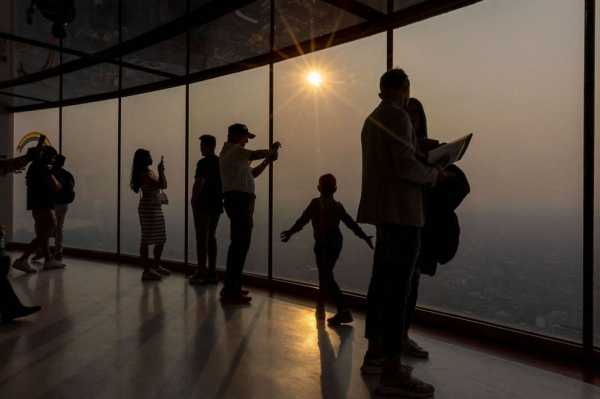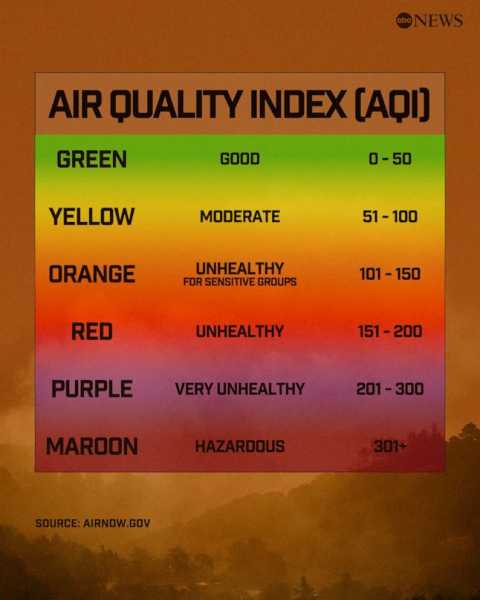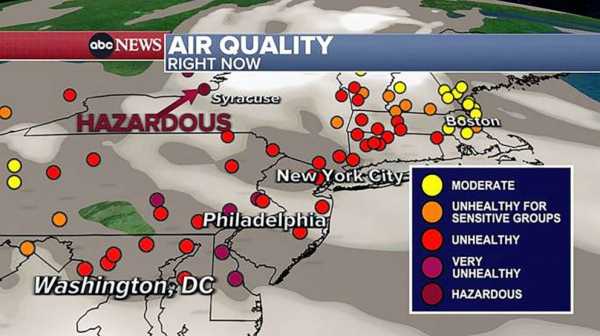Heavy blankets of smoke billowing over the U.S. from the wildfires burning in Canada are threatening the health of millions of people — even non-vulnerable populations with no preexisting conditions.
But what about the smoke makes it so hazardous for humans to be around?
MORE: Why smoke from wildfires could cause a host of symptoms — even in healthy people
Wildfire smoke contains fine particulate matter, known as PM2.5, which are microscopic solid or liquid droplets — often 30 times smaller than the diameter of a human hair — that can be inhaled and cause serious health problems, according to the U.S. Environmental Protection Agency.
Most particles form in the atmosphere as a result of complex reactions of chemicals, such as sulfur dioxide and nitrogen oxides — pollutants emitted from power plants, industries and automobiles.

People take photographs as a smokey Toronto is seen from the CN Tower as wildfires in Ontario and Quebec continue to burn, in Toronto, June 6, 2023.Carlos Osorio/Reuters
But wildfires likely contain PM2.5 that is up to 10 times more harmful than the same type of air pollution coming from combustion activity, according to a 2021 study conducted in California.
"The top offender here is these fine particles," Dr. Vijay Limaye, a climate and health scientist at the National Resources Defense Council, told ABC News. "That size is really important because it can penetrate really deeply and wreak havoc on the body."
MORE: Canadian wildfire smoke live updates: Air quality alerts issued for 13 states
PM2.5 is considered unhealthy for "Code Orange" and sensitive groups once the Air Quality Index surpasses 100, according to AirNow, a website that publishes air quality data. Once the AQI surpasses 150, it is considered "Code Red," unhealthy for some members of the general public who may experience health effects, with sensitive groups experiencing more severe effects.
The AQI is at "Code Purple" once it surpasses 200, considered "very unhealthy" with increased health risk for all populations. "Code Maroon" is labeled as "hazardous" and a health warning for emergency conditions once the AQI reaches 300 and higher.

Air Quality Index (AQI)ABC News Photo Illustration
At Code Maroon, "everyone is more likely to be affected," according to AirNow.
A "good" AQI is measured at 50 and below, and a "moderate" air quality index ranks between 51 and 100.
MORE: Wildfire smoke map: Which US cities, states are being impacted by Canadian wildfires
New York City shattered its record for the highest AQI since records began in 1999, measuring in at 413 on Wednesday afternoon.
Philadelphia ranked at 233 on Wednesday afternoon, while Washington, D.C., measured at 168 and Baltimore at 153, according to AirNow.

The worst air quality in the U.S. on the morning of June 7, 2023, was in New York from Syracuse to Binghamton.ABC News
Because the particles are microscopic, they can easily enter the nose and throat and can travel to the lungs, with some of the smallest particles even circulating in the bloodstream, according to the EPA.
Inhaling toxic smoke and ash from wildfires could weaken the immune system and cause damage to the body, including the lungs and heart, for anyone regardless of their health status.
MORE: New York blanketed by haze from Canadian wildfires
Exposure to concentrated amounts of PM2.5 can cause short-term effects such as irritation of the eyes, nose and throat; coughing, sneezing and shortness of breath, and long-term effects such as worsening of conditions including asthma and heart disease, according to the EPA.
Sourse: abcnews.go.com






